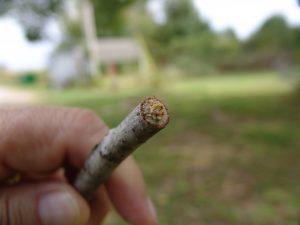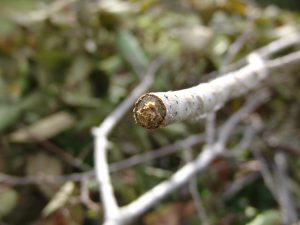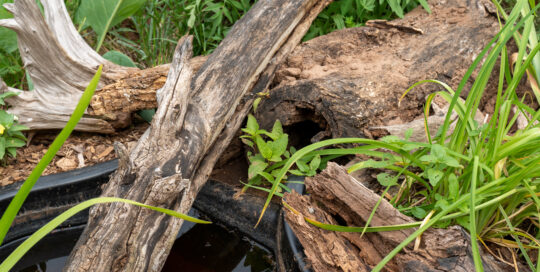Fallen branches? Check for twig girdlers.
Views: 1902

I found a new beetle in my yard this month: a twig girdler. My county extension agent, Keith, sent out notice last month that he’d been getting inquiries about fallen branches. Investigations revealed the culprit: the beetle, Oncideres cingulate, or twig girdler. I didn’t think much about it until I noticed storm-like damage to one of my elm trees, with many small branches and twigs scattered about on the ground. The only weird thing was: We hadn’t had a recent storm. Remembering the message sent by Keith, I checked the branches, and sure enough, they had the tell-tale smooth ends indicating they had been chewed off, rather than broken off.

Damage to a branch caused by twig girdlers.
It was pretty cool to recognize an issue and diagnose the cause so quickly. My elm is so tall I couldn’t see any of the insects responsible, however. They are camouflaged to blend into bark, and they’re less than an inch long.

Twig Girdler, Courtesy of Clemson University – USDA Cooperative Extension Slide Series, Bugwood.org
Details about Twig Girdlers
Twig girdlers tend to attack elms, pecans, and hickories, but may also be found on oaks, hackberries, and other ornamental trees. They also damage fruit trees, including persimmons. These beetles rarely do enough damage to seriously hurt trees, although they can adversely affect pecan harvests, young pecan nurseries, and fruit orchards. As with my elm, they can make any tree look somewhat ragged.
Twig girdlers lay their eggs under the bark on the branch or twig that they then gnaw off. The larvae overwinter in the fallen wood, boring into it for food and shelter. In spring, the larvae will eat much of the internal wood beneath the bark before pupating in the cavity they create. Adults emerge in late summer or early fall, starting the cycle all over again.
Managing Twig Girdlers
The best method to control twig girdlers is to get rid of the fallen twigs so you don’t have any offspring emerging the next year. I’ve been picking up fallen twigs every few days to throw away or use as kindling for our fire pit. Orchard owners and pecan growers might need to do control with a commercial insecticide if they have a severe infestation.
Here is a short video about twig girdlers.
In other notes, many migrants are on the move right now, from monarch butterflies to hawks, warblers, and hummingbirds. While this may be the tail end of migration season for many, keep water and food sources out to support these travelers; remember that some may be traveling south from as far north as Canada, with many hundreds of miles still to go. They benefit from easy energy sources provided by bird feeders, hummingbird feeders, and nectar sources. Keep these available for any stragglers. I typically keep a hummingbird feeder out until November, just in case.
Meet Leslie Miller
Leslie Ann Miller shares 3.5 acres in rural Oklahoma with birds, butterflies and wide variety of animals. She is currently transforming her yard with plantings…
Leslie's Recent Posts

Creating microclimates and microhabitats to benefit wildlife






